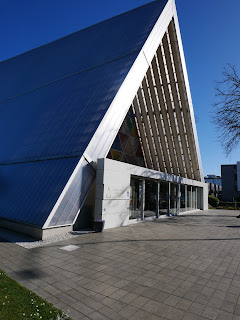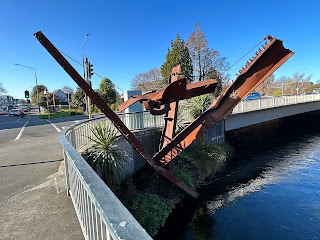I am glad I double checked my list of things-to-do in Christchurch and noticed the Cardboard Cathedral because it is located just enough off of the tourist path I could have easily forgotten about it. Instead, it turned out to become one of my highlights.
When we entered the narthex, we were greeted by Peter, a warm ambassador of the church. He handed us a cardboard pen as a souvenir. Traveling with carry-ons only means being selective in our souvenir gathering. Turns it, it is a really nice pen -- a rare free pen that writes in blue ink.
Peter enlightened us on the history. Christchurch had an earthquake in 2010, which closed the cathedral and many other buildings while they assessed the damage and determined the safety of continuing to use the building. In 2016 Wellington went through a similar assessment following their earthquake. In the case of Christchurch, a few weeks later the cathedral was deemed safe and they returned to worshipping in it. When the second massive earthquake hit in February 2011 and a tower collapsed they knew they would be out of that space for a lot longer. I don't think they realized it would be more than a decade before groups of 20 people would be allowed inside wearing hardhats, but that's what happened. In 2023 the cathedral's leadership was allowed inside to see the damage for themselves.
A lot of tough decisions had to be made and fairly quickly. At first they worshipped in the chapel at the local boys' school, but as an active church with multiple worship services, funerals, the school's church services, it was already crowded before a duck moved into the sanctuary deciding that was the perfect spot to have her dozen ducklings. I wish I could find a news article to verify the last part of that sentence.
 |
| There were markers indicating where to put the chairs, but the space is flexible for mixed use |
 |
| The lectern reminded me of the one was saw in Wellington at Old St. Paul's |
 |
| A surprising amount of light shines in |
 |
| The pulpit, choir loft, and even the cross are made out of cardboard |
 |
| The 79-foot tall A-frame building uses 86 cardboard tubes. |
After walking around the sanctuary taking pictures and studying the structure, we started to talk to Ralph, a retired pilot likely closer to eighty than sixty, but had the energy of someone younger than us.
 |
| Kahikatea Memorial Sculpture in memory of the 28 Japanese and all other earthquake victims on February 22, 2011 An identical one is in Toyama Japan |
Ralph was quick to reinforce that despite it being made out of container ships and cardboard, this is not a "temporary" church, but a "transitional" church. The building was made in 10 months by a Japanese company from the area where 25 Japanese students who were killed in the earthquake while studying in Christchurch lived. Let that sink in a moment. Only 185 people perished. Twenty-five of them from one area in Japan. The architect donated his services to help the church and community rebuild. It took longer to get the building permits and cut through the red tape than it took to build the church.
Ralph had to get back to the busload of Japanese tourists, but upon hearing we were from near New York, he told us as a retired pilot 9/11 hit him hard. Two days ago, on the 22nd anniversary, the church held a memorial service. A short distance away on the river are two sculptures made from beams from the 102nd floor of Tower 2.
With that, we decided to walk to the memorial. Twenty-two years and two days after the attacks, it still feels like yesterday. I can almost smell the smoke wafting into Princeton and see the clear blue sky, and realize I was pregnant with the start of the next generation in our family.
The sculpture was a donation to the Christchurch Fire and Rescue Team in honor of their help following the attacks.
 |
| Barely a year after the attacks |
 |
| A service is held here every year in memory |
 |
| The sculpture spans both sides of the water |




No comments:
Post a Comment